|
|
|
|
 |
OTHER MAMMALS: Cottontail Rabbits |
|
|
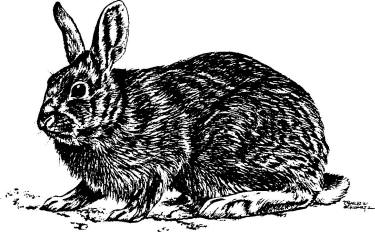
Fig. 1. Eastern cottontail
rabbit, Sylvilagus floridanus
Introduction
Rabbits mean different
things to different people. For hunters, the cottontail
rabbit is an abundant, sporting, and tasty game animal.
However, vegetable and flower gardeners, farmers, and
homeowners who are suffering damage may have very little
to say in favor of cottontails. They can do considerable
damage to flowers, vegetables, trees, and shrubs any
time of the year and in places ranging from suburban
yards to rural fields and tree plantations. Control is
often necessary to reduce damage, but complete
extermination is not necessary, desirable, or even
possible.
Rabbits usually can be
accepted as interesting additions to the backyard or
rural landscape if control techniques are applied
correctly. Under some unusual circumstances, control of
damage may be difficult.
Damage control methods
include removal by live trapping or hunting, exclusion,
and chemical repellents. In general, no toxicants or
fumigants are registered for rabbit control; however,
state regulations may vary. Frightening devices may
provide a sense of security for the property owner, but
they rarely diminish rabbit damage.
Identification
There are 13 species of
cottontail rabbits (genus Sylvilagus), nine of which are
found in various sections of North America north of
Mexico. All nine are similar in general appearance and
behavior, but differ in size, range, and habitat. Such
differences result in a wide variation of damage
problems, or lack of problems. The pygmy rabbit (S.
idahoensis), found in the Pacific Northwest, weighs only
1 pound (0.4 kg), while the swamp rabbit (S. aquaticus),
found in the southeastern states as far north as
southern Illinois, may weigh up to 5 pounds (2.3 kg).
Most species prefer open, brushy, or cultivated areas
but some frequent marshes, swamps, or deserts. The swamp
rabbit and the marsh rabbit (S. palustris) are strong
swimmers. The eastern cottontail (S. floridanus) is the
most abundant and widespread species. For the purposes
of the discussion here about damage control and biology,
the eastern cottontail (Fig. 1) will be considered
representative of the genus. Cottontail rabbits must be
distinguished from jackrabbits and other hares, which
are generally larger in size and have longer ears.
Jackrabbits are discussed in another chapter of this
book.
The eastern cottontail
rabbit is approximately 15 to 19 inches (37 to 48 cm) in
length and weighs 2 to 4 pounds (0.9 to 1.8 kg). Males
and females are basically the same size and color.
Cottontails appear gray or brownish gray in the field.
Closer examination reveals a grizzled blend of white,
gray, brown, and black guard hairs over a soft grayish
or brownish underfur, with a characteristic rusty brown
spot on the nape of the neck. Rabbits molt twice each
year, but remain the same general color. They have large
ears, though smaller than those of jackrabbits, and the
hind feet are much larger than the forefeet. The tail is
short and white on the undersurface, and its similarity
to a cotton ball resulted in the rabbits common name.
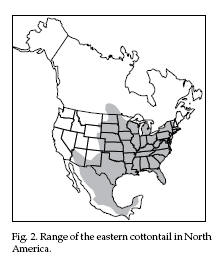 Range Range
The eastern cottontail's
range includes the entire United States east of the
Rocky Mountains and introductions further west. It
extends from southern New England along the Canadian
border west to eastern Montana and south into Mexico and
South America (Fig. 2). The most common species of the
western United States include the desert cottontail (S.
auduboni, Fig. 3), and mountain cottontail (S. muttalli,
Fig. 4). Refer to a field guide or suggested readings if
other species of the genus Sylvilagus are of interest.
Habitat
Cottontails do not
distribute themselves evenly across the landscape. They
tend to concentrate in favorable habitat such as brushy
fence rows or field edges, gullies filled with debris,
brush piles, or landscaped backyards where food and
cover are suitable. They are rarely found in dense
forests or open grasslands, but fallow crop fields, such
as those in the Conservation Reserve Program, may
provide suitable habitat.
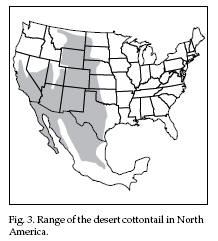 Cottontails
generally spend their entire lives in an area of 10
acres or less. Occasionally they may move a mile or so
from summer range to winter cover or to a new food
supply. Lack of food or cover is usually the motivation
for a rabbit to relocate. In suburban areas, rabbits are
numerous and mobile enough to fill any habitat created
when other rabbits are removed. Population density
varies with habitat quality, but one rabbit per acre is
a reasonable average. Cottontails
generally spend their entire lives in an area of 10
acres or less. Occasionally they may move a mile or so
from summer range to winter cover or to a new food
supply. Lack of food or cover is usually the motivation
for a rabbit to relocate. In suburban areas, rabbits are
numerous and mobile enough to fill any habitat created
when other rabbits are removed. Population density
varies with habitat quality, but one rabbit per acre is
a reasonable average.
Contrary to popular
belief, cottontails do not dig their own burrows, as the
European rabbit does. Cottontails use natural cavities
or burrows excavated by woodchucks or other animals.
Underground dens are used
primarily in extremely cold or wet weather and to escape
pursuit. Brush piles and other areas of cover are often
adequate alternatives to burrows.
In spring and fall,
rabbits use a grass or weed shelter. The form is a
nestlike cavity on the surface of the ground, usually
made in dense cover. It gives the rabbit some protection
from weather, but is largely used for concealment. In
summer, lush green growth provides both food and
shelter, so there is little need for a form.
General Biology and Reproduction
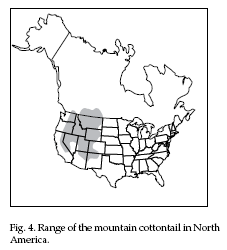 Rabbits
live only 12 to 15 months, and probably only one rabbit
in 100 lives to see its third fall, yet they make the
most of the time available to them. Cottontails can
raise as many as 6 litters in a year. Typically, there
are 2 to 3 litters per year in northern parts of the
cottontail range and up to 5 to 6 in southern areas. In
the north (Wisconsin), first litters are born as early
as late March or April. In the south (Texas), litters
may be born year-round. Litter size also varies with
latitude; rabbits produce 5 to 6 young per litter in the
north, 2 to 3 in the south. The rabbit's gestation
period is only 28 or 29 days, and a female is usually
bred again within a few hours of giving birth. Rabbits
give birth in a shallow nest depression in the ground.
Young cottontails are born nearly furless with their
eyes closed. Their eyes open in 7 to 8 days, and they
leave the nest in 2 to 3 weeks. Rabbits
live only 12 to 15 months, and probably only one rabbit
in 100 lives to see its third fall, yet they make the
most of the time available to them. Cottontails can
raise as many as 6 litters in a year. Typically, there
are 2 to 3 litters per year in northern parts of the
cottontail range and up to 5 to 6 in southern areas. In
the north (Wisconsin), first litters are born as early
as late March or April. In the south (Texas), litters
may be born year-round. Litter size also varies with
latitude; rabbits produce 5 to 6 young per litter in the
north, 2 to 3 in the south. The rabbit's gestation
period is only 28 or 29 days, and a female is usually
bred again within a few hours of giving birth. Rabbits
give birth in a shallow nest depression in the ground.
Young cottontails are born nearly furless with their
eyes closed. Their eyes open in 7 to 8 days, and they
leave the nest in 2 to 3 weeks.
Under good conditions,
each pair of rabbits could produce approximately 18
young during the breeding season. Fortunately, this
potential is rarely reached. Weather, disease,
predators, encounters with cars and hunters, and other
mortality factors combine to keep a lid on the rabbit
population.
Because of the cottontails
reproductive potential, no lethal control is effective
for more than a limited period. Control measures are
most effective when used against the breeding population
during the winter. Habitat modification and exclusion
techniques provide long-term, nonlethal control.
Food Habits, Damage, and Damage Identification
The appetite of a rabbit
can cause problems every season of the year. Rabbits eat
flowers and vegetables in spring and summer. In fall and
winter, they damage and kill valuable woody plants.
Rabbits will devour a wide
variety of flowers. The one most commonly damaged is the
tulip; they especially like the first shoots that appear
in early spring.
The proverbial carrot
certainly is not the only vegetable that cottontails
eat. Anyone who has had a row of peas, beans, or beets
pruned to ground level knows how rabbits like these
plants. Only a few crops, corn, squash, cucumbers,
tomatoes, potatoes, and some peppers seem to be immune
from rabbit problems.
Equally annoying, and much
more serious, is the damage rabbits do to woody plants
by gnawing bark or clipping off branches, stems, and
buds. In winter in northern states, when the ground is
covered with snow for long periods, rabbits often
severely damage expensive home landscape plants,
orchards, forest plantations, and park trees and shrubs.
Some young plants are clipped off at snow height, and
large trees and shrubs may be completely girdled. When
the latter happens, only sprouting from beneath the
damage or a delicate bridge graft around the damage will
save the plant.
A rabbit's tastes in food
can vary considerably by region and season. In general,
cottontails seem to prefer plants of the rose family.
Apple trees, black and red raspberries, and blackberries
are the most frequently damaged food-producing woody
plants, although cherry, plum, and nut trees are also
damaged.
Among shade and ornamental
trees, the hardest hit are mountain ash, basswood, red
maple, sugar maple, honey locust, ironwood, red and
white oak, and willow. Sumac, rose, Japanese barberry,
dogwood, and some woody members of the pea family are
among the shrubs damaged. Evergreens seem to be more
susceptible to rabbit damage in some areas than in
others. Young trees may be clipped off, and older trees
may be deformed or killed.
The character of the bark
on woody plants also influences rabbit browsing. Most
young trees have smooth, thin bark with green food
material just beneath it. Such bark provides an
easy-to-get food source for rabbits. The thick, rough
bark of older trees often discourages gnawing. Even on
the same plant, rabbits avoid the rough bark but girdle
the young sprouts that have smooth bark.
Rabbit damage can be
identified by the characteristic appearance of gnawing
on older woody growth and the clean-cut, angled clipping
of young stems. Distinctive round droppings in the
immediate area are a good sign of their presence too.
Rabbit damage rarely
reaches economic significance in commercial fields or
plantations, but there are exceptions. For example,
marsh rabbits have been implicated in sugarcane damage
in Florida. Growers should always be alert to the
potential problems caused by locally high rabbit
populations.
Legal Status
In most states, rabbits
are classified as game animals and are protected as such
at all times except during the legal hunting season.
Some state regulations may grant exceptions to property
owners, allowing them to trap or shoot rabbits outside
the normal hunting season on their own property.
Damage Prevention and Control Methods
Exclusion
One of the best ways to
protect a backyard garden or berry patch is to put up a
fence. It does not have to be tall or especially sturdy.
A fence of 2-foot (60cm) chicken wire with the bottom
tight to the ground or buried a few inches is
sufficient. Be sure the mesh is 1 inch
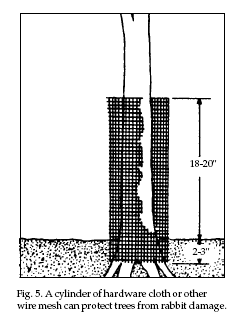 (2.5
cm) or smaller so that young rabbits will not be able to
go through it. A more substantial fence of welded wire,
chain link, or hog wire will keep rabbits, pets, and
children out of the garden and can be used to trellis
vine crops. The lower 1 1/2 to 2 feet (45 to 60 cm)
should be covered with small mesh wire. A fence may seem
costly, but with proper care it will last many years and
provide relief from the constant aggravation of rabbit
damage. Inexpensive chicken wire can be replaced every
few years. (2.5
cm) or smaller so that young rabbits will not be able to
go through it. A more substantial fence of welded wire,
chain link, or hog wire will keep rabbits, pets, and
children out of the garden and can be used to trellis
vine crops. The lower 1 1/2 to 2 feet (45 to 60 cm)
should be covered with small mesh wire. A fence may seem
costly, but with proper care it will last many years and
provide relief from the constant aggravation of rabbit
damage. Inexpensive chicken wire can be replaced every
few years.
Cylinders of 1/4-inch
(0.6-cm) wire hardware cloth will protect valuable young
orchard trees or landscape plants (Fig. 5). The
cylinders should extend higher than a rabbits reach
while standing on the expected snow depth, and stand 1
to 2 inches (2.5 to 5 cm) out from the tree trunk.
Larger mesh sizes, 1/2- to 3/4-inch (1.2-to 1.8-cm), can
be used to reduce cost, but be sure the cylinder stands
far enough away from the tree trunk that rabbits cannot
eat through the holes. Commercial tree guards or tree
wrap are another alternative. Several types of paper
wrap are available, but they are designed for protection
from sun or other damage. Check with your local garden
center for advice. When rabbits are abundant and food is
in short supply, only hardware cloth will guarantee
protection. Small mesh (1/4-inch [0.6-cm]) hardware
cloth also protects against mouse damage.
A dome or cage of chicken
wire secured over a small flower bed will allow
vulnerable plants such as tulips to get a good start
before they are left unprotected.
Habitat Modification
One form of natural
control is manipulation of the rabbits habitat. Although
frequently overlooked, removing brush piles, weed
patches, dumps, stone piles, and other debris where
rabbits live and hide can be an excellent way to manage
rabbits. It is especially effective in suburban areas
where fewer suitable habitats are likely to be
available. Vegetation control along ditch banks or fence
rows will eliminate rabbit habitat in agricultural
settings but is likely to have detrimental effects on
other species such as pheasants. Always weigh the
consequences before carrying out any form of habitat
management.
Repellents
Several chemical
repellents discourage rabbit browsing. Always follow
exactly the directions for application on the container.
Remember that some repellents are poisonous and require
safe storage and use. For best results, use repellents
and other damage control methods at the first sign of
damage.
Most repellents can be
applied, like paint, with a brush or sprayer. Many
commercially available repellents contain the fungicide
thiram and can be purchased in a ready-to-use form (see
Supplies and Materials).
Some formerly recommended
repellents are no longer available. Most repellents are
not designed to be used on plants or plant parts
destined for human consumption. Most rabbit repellents
are contact or taste repellents that render the treated
plant parts distasteful. Mothballs are an example of an
area or odor repellent that repels by creating a noxious
odor around the plants to be protected. Taste repellents
protect only the parts of the plant they contact; new
growth that emerges after application is not protected.
Heavy rains may necessitate reapplication of some
repellents.
Mothballs or dried blood
meal sometimes keeps rabbits from damaging small flower
beds or garden plots. Place these substances among the
plants. Blood meal does not weather well, however.
Taste repellents are
usually more effective than odor repellents. The degree
of efficacy, however, is highly variable, depending on
the behavior and number of rabbits, and alternative
foods available. When rabbits are abundant and hungry,
use other control techniques along with chemical
repellents.
Toxicants
There are no toxicants or fumigants registered for use
against rabbits. Poisoning rabbits is not recommended.
Since state pesticide registrations vary, check with
your local Cooperative Extension Service or
USDA-APHIS-ADC office for information on repellents or
other new products available for use in your area.
Trapping
Trapping is the best way to remove rabbits in
cities, parks, and suburban areas. The first step is to
get a well built and well-designed live trap. Several
excellent styles of commercial live traps are available
from garden centers, hardware stores, and seed catalogs.
Most commercial traps are wire and last indefinitely
with proper care. Average cost is about $20 to $30. Live
traps can often be rented from animal control offices or
pest control companies. An effective wooden box trap
(Fig. 6) can be made. This type of trap has proven
itself in the field and has been used in rabbit research
by biologists. For best results, follow the plan to the
letter because each detail has been carefully worked
out. Place traps where you know rabbits feed or rest.
Keep traps near cover that rabbits won't have to cross
large open areas to get to them. In winter, face traps
away from prevailing winds to keep snow and dry leaves
from plugging the entrance or interfering with the door.
Check traps daily to replenish bait or remove the
catches daily checks are essential for effective control
and for humane treatment of the animals. Move traps if
they fail to make a catch within a week.
Finding bait is not a
problem, even in winter, because cob corn (dry ear corn)
or dried apples make very good bait. Impale the bait on
the nail or simply position it at the rear of the trap
(commercial traps may not have a nail). When using cob
corn, use half a cob and push the nail into the pith of
the cob; this keeps the cob off the floor and visible
from the open door. Dried leafy alfalfa and clover are
also good cold weather baits.

Apples, carrots, cabbage,
and other fresh green vegetables are good baits in
warmer weather or climates. These soft baits become
mushy and ineffective once frozen. A good summer bait
for garden traps is a cabbage leaf rolled tightly and
held together by a toothpick. For best results, use
baits that are similar to what the target rabbits are
feeding on.
A commercial wire trap can
be made more effective (especially in winter) by
covering it with canvas or some other dark material. Be
sure the cover does not interfere with the trap’s
mechanism.
Release rabbits in rural
areas several miles from where they have been trapped if
local regulations allow relocation. Do not release them
where they may create a problem for someone else.
Shooting
Shooting is a quick, easy, and effective method of
control, but make sure that local firearms laws allow it
and that it is done safely. In some states, the owner or
occupant of a parcel of land may hunt rabbits all year
on that land, except for a short time before the firearm
deer season. Consult your state wildlife agency for
regulations. You must be persistent if shooting is the
only technique you rely on. Removing rabbits in one year
never guarantees that the rabbit population will be low
the next year (this is also true for trapping).
Other Methods
Encouraging the rabbits natural enemies or at least
not interfering with them may aid in reducing rabbit
damage. Hawks, owls, foxes, mink, weasels, and snakes
all help the farmer, gardener, homeowner, and forester
control rabbits. These animals should never be
needlessly destroyed. In fact, it is against the law to
kill hawks and owls; foxes, mink, and weasels are
protected during certain seasons as valuable furbearers.
Even the family cat can be a very effective predator on
young nestling rabbits, but cats are likely to kill
other wildlife as well.
Many people have a
favorite rabbit remedy. A piece of rubber hose on the
ground may look enough like a snake to scare rabbits
away. Another remedy calls for placing large, clear
glass jars of water in a garden. Supposedly, rabbits are
terrified by their distorted reflections. Most home
remedies, unfortunately, are not very effective.
Inflatable owls and snakes, eyespot balloons, and other
commercial products are readily available in garden
centers and through mail order catalogues. Feeding
rabbits during the winter in much the same way as
feeding wild birds might divert their attention from
trees and shrubs and thus reduce damage in some areas.
There is always the risk that this tactic can backfire
by drawing in greater numbers of rabbits or increasing
the survival of those present.
Acknowledgments
I thank R. A. McCabe for
reviewing this manuscript and providing the trap design.
Figure 1 from Schwartz and
Schwartz (1981).
Figures 2 and 3 adapted
from Burt and Grossenheider (1976) by Dave Thornhill,
University of Nebraska-Lincoln.
Figures 4 and 5 courtesy
of the Department of Agricultural Journalism, University
of Wisconsin-Madison.
For Additional Information
Burt, W. H., and R. P.
Grossenheider. 1976. A field guide to the mammals, 3d
ed. Houghton Mifflin Co., Boston. 289 pp.
Chapman, J. A., J. G.
Hockman, and W. R. Edwards. 1982. Cottontails. Pages
83-123 in J. A. Chapman and G. A. Feldhamer, eds. Wild
mammals of North America: biology, management and
economics. The Johns Hopkins Univ. Press, Baltimore.
Chapman, J. A., J. G.
Hockman, and Magaly M. Ojeda C. 1980. Sylvilagus
floridanus. Mammal. Sp. 136:1-8.
Jackson, H. H. T. 1961.
The mammals of Wisconsin. Univ. Wisconsin Press,
Madison. 504 pp.
McDonald, D. 1984.
Lagomorphs. Pages 714-721 in D. McDonald, ed. The
encyclopedia of mammals. Facts on File Publications, New
York.
Editors
Scott E. Hygnstrom; Robert
M. Timm; Gary E. Larson
PREVENTION AND CONTROL OF
WILDLIFE DAMAGE — 1994 Cooperative Extension Division
Institute of Agriculture and Natural Resources
University of Nebraska -Lincoln
United States Department
of Agriculture Animal and Plant Health Inspection
Service Animal Damage Control
Great Plains Agricultural
Council Wildlife Committee
01/25/2007
Special
thanks to:
Clemson University
|